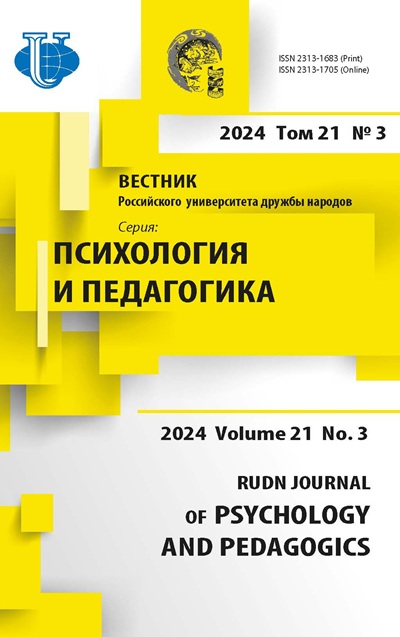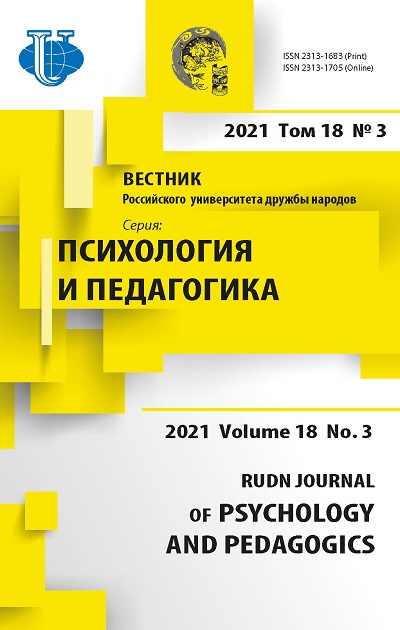Sex and Age Differences in the Personal Orientation of User Activity in the Russian Social Network “VKontakte”
- Authors: Kornienko D.S.1, Derish F.V.2, Nikitina E.Y.2
-
Affiliations:
- The Russian Presidential Academy of National Economy and Public Administration
- Perm State University
- Issue: Vol 18, No 3 (2021)
- Pages: 631-649
- Section: PERSONALITY IN THE GLOBAL DIGITAL SPACE
- URL: https://journals.rudn.ru/psychology-pedagogics/article/view/27600
- DOI: https://doi.org/10.22363/2313-1683-2021-18-3-631-649
Cite item
Full Text
Abstract
The role of factors of individual differences in user activity in the Russian social network “VKontakte” is analyzed. At the moment, in Russian psychology, there are several directions for the study of user activity in social networks. However, none of them has considered user sex and age differences. There are also limitations due to the predominance of subjective indicators in assessing user activity. The aim of this work is to study sex and age differences through the analysis of objective data on the profiles of social network users. The paper also provides an overview of modern Russian studies on sex and age differences in user activity. Using a comparative analysis of groups and analysis of the structure of relationships between indicators of user activity, the 9699 profiles of users of the social network “VKontakte” at the ages from 18 to 55 were examined. As a result, multiple individual differences were found in relation to the sex and age of the users. Additionally, the structure of user activity was obtained, consisting of two components: “Self-presentation” and “Utilitarianism”. These components characterize the personal orientation in the use of the social network. Sex and age play a significant role as factors of individual differences. The most important thing has turned out to be that men are more focused on expanding the circle of acquaintances, which is an attribute of status. Women, on the contrary, are generally characterized by greater activity in the social network, a greater desire to present themselves and a greater focus on other people. Young people - aged 18-25 years - are less active users, they often use the social network as a source of video content. Users belonging to the older age groups differ slightly from one another.
About the authors
Dmitrii S. Kornienko
The Russian Presidential Academy of National Economy and Public Administration
Author for correspondence.
Email: dscorney@mail.ru
ORCID iD: 0000-0002-6597-264X
Doctor of Psychological Sciences, Associate Professor, is Professor of the Department of General Psychology, Institute of Social Sciences
82 Vernadsky Prospekt, Moscow, 119571, Russian FederationFedor V. Derish
Perm State University
Email: fedor.derish@gmail.com
ORCID iD: 0000-0001-8929-9093
senior lecturer of the Department of General and Clinical Psychology
15 Bukireva St, Perm, 614990, Russian FederationElena Yu. Nikitina
Perm State University
Email: neyu@psu.ru
PhD in Physical and Mathematical Sciences, is Associate Professor of the Department of Information Security and Communication Systems
15 Bukireva St, Perm, 614990, Russian FederationReferences
- Agadullina, E.R. (2015). Social networks user: Current research. Journal of Modern Foreign Psychology, 4(3), 36–46. (In Russ.) https://doi.org/10.17759/jmfp.2015040305
- Back, M.D., Stopfer, J.M., Vazire, S., Gaddis, S., Schmukle, S.C., Eglof, B., & Gosling, S.D. (2010). Facebook profiles reflect actual personality not self-idealization. Psychological Science, 21, 372–374. https://doi.org/10.1177/0956797609360756
- Barker, V. (2009). Older adolescents’ motivations for social network site use: The influence of gender, group identity, and collective self-esteem. Cyberpsychology and Behavior: The Impact of the Internet, Multimedia and Virtual Reality on Behavior and Society, 12(2), 209–213. https://doi.org/10.1089/cpb.2008.0228
- Belinskaya, E.P. (2013). Information socialization of adolescents: The experience of using social networks and psychological well-being. Psychological Studies, 6(30), 6. (In Russ.)
- Blomfield Neira, C.J., & Barber, B.L. (2014). Social networking site use: Linked to adolescents’ social self-concept, self-esteem, and depressed mood. Australian Journal of Psychology, 66, 56–64. https://doi.org/10.1111/ajpy.12034
- Chae, D., Kim, H., & Kim, Y.A. (2018). Sex differences in the factors influencing Korean college students’ addictive tendency toward social networking sites. International Journal of Mental Health and Addiction, 16, 339–350. https://doi.org/10.1007/s11469-017-9778-3
- Frindte, V., & Keler, T. (2000). Publichnoe konstruirovanie “Ya” v oposredstvovannom komp'yuterom obshchenii. In A.E. Voiskunsky (Ed.), Gumanitarnye Issledovaniya v Internete (pp. 40–54). Mozhaisk: Mozhaisk-Terra Publ. (In Russ.)
- Fyodorov, V.V., & Mileev, I.D. (2015). Motivation in teenage users of social media. Social Psychology and Society, 6(3), 98–108. (In Russ.) https://doi.org/10.17759/sps.2015060307
- Gosling, S.D., Augustine, A.A., Vazire, S., Holtzman, N., & Gaddis, S. (2011). Manifestations of personality in online social networks: Self-reported Facebook-related behaviors and observable profile information. Cyberpsychology, Behavior and Social Networking, 14, 483–488. https://doi.org/10.1089/cyber.2010.0087
- Gurkina, O.A., & Maltseva, D.V. (2015). Motives of social network use by adolescence. Sotsiologicheskie Issledovaniya, (5), 123–130. (In Russ.)
- Jackson, L.A., Ervin, K.S., Gardner, P.D., & Schmitt, N. (2001). Gender and the Internet: Women communicating and men searching. Sex Roles: A Journal of Research, 44(5–6), 363–379. https://doi.org/10.1023/A:1010937901821
- Joinson, A. (2002). Understanding the psychology of Internet behaviour: Virtual worlds, real lives. Houndmills, UK; New York: Palgrave Macmillan.
- Jonason, P.K., Slomski, S., & Partyka, J. (2012). The Dark Triad at work: How toxic employees get their way. Personality and Individual Differences, 52(3), 449–453. https://doi.org/10.1016/j.paid.2011.11.008
- Khoroshikh, V.V., & Charykova, E.В. (2017). Aspects of variation of adolescents’ virtual self-presentation. The Bulletin of Irkutsk State University. Series “Psychology”, 19, 103–112. (In Russ.)
- Kornienko, D.S., & Derish, F.V. (2019). Psychometric properties of the short Dark Triad measure. Perm University Herald. Series: Philosophy. Psychology. Sociology, (4), 525–538. (In Russ.) https://doi.org/10.17072/2078-7898/2019-4-525-538
- Kornienko, D.S., & Rudnova, N.A. (2018). Online social network usage, procrastination and self-regulation. Psychological Studies, 11(59), 9. (In Russ.)
- Kosinski, M., Stillwell, D., & Graepel, T. (2013). Private traits and attributes are predictable from digital records of human behavior. Proceedings of the National Academy of Sciences, 110(15), 5802–5805. https://doi.org/10.1073/pnas.1218772110
- Krasavtseva, Y., & Kornilova, T. (2016). The Dark Triad traits in the regulation of decision-making strategies. Bulletin of Moscow State Regional University. Series: Psychology, (2), 22–33. (In Russ.) https://doi.org/10.18384/2310-7235-2016-2-22-33
- McAndrew, F.T., & Jeong, H.S. (2012). Who does what on Facebook? Age, sex, and relationship status as predictors of Facebook use. Computers in Human Behavior, 28(6), 2359–2365. https://doi.org/10.1016/j.chb.2012.07.007
- Nikitina, D.A. (2019). Peculiarities of self-evaluation of the external appearance and socio-demographic characteristics of young people with various variability of the self-presentation of the external appearance in public space. Colloquium-Journal, (24), 27–29. (In Russ.)
- Pempek, T., Yermolayeva, Y., & Calvert, S.L. (2009). College students’ social networking experiences on Facebook. Journal of Applied Developmental Psychology, 30(3), 227–238. https://doi.org/10.1016/j.appdev.2008.12.010
- Pilishvili, T.S. (2015). Features of activity in virtual and everyday life. Kostroma State University Bulletin, (21), 53–56. (In Russ.)
- Polivanova, K.N., & Smirnov, I.B. (2017). What’s in my profile: VKontakte data as a tool for studying the interests of modern teenagers. Educational Studies, (2), 134–152. (In Russ.) https://doi.org/10.17323/1814-9545-2017-2-134-152
- Poulin, M.J., & Hasse, C.M. (2015). Growing to trust: Evidence that trust increase and sustains well-being across the lifespan. Social Psychological and Personality Science, 6(6), 614–621. https://doi.org/10.1177/1948550615574301
- Ryabikina, Z.I., & Bogomolova, E.I. (2015). Interrelation personality characteristics of users of social networks in the internet with the features of their network activity. Scientific Journal of KubSAU, 109(05), 1–17. (In Russ.).
- Shchekoturov, A.V. (2012). Construction of adolescents’ virtual gender identity in the social network web-site “VKontakte”. Woman in Russian Society, (4), 31–43. (In Russ.)
- Sobkin, V.S., & Vedotova, A.V. (2019). Adolescent aggression in social media: Perception and personal experience. Psychological Science and Education, 24(2), 5–18. (In Russ.) https://doi.org/10.17759/pse.2019240201
- Valkenburg, P.M., Peter, J., & Schouten, A.P. (2006). Friend networking sites and their relationship to adolescents’ well-being and social self-esteem. Cyberpsychology and Behavior, 9(5), 584–590. https://doi.org/10.1089/cpb.2006.9.584
- Voiskounsky, A.E., Evdokimenko, A.S., & Fedunina, N.Yu. (2013). Alternative identity in social networks. Moscow University Psychology Bulletin, (1), 66–83. (In Russ.)
- Voiskounsky, A.E., Evdokimenko, A.S., & Fedunina, N.Yu. (2014). Ethical orientation of adolescents and young adults in social networks. Psychological Studies, 7(37), 2. (In Russ.)
- Voiskunsky, A.E. (2010). Psikhologiya i Internet. Moscow: Acropol Publ. (In Russ.)
- Wang, Y.-C., Burke, M., & Kraut, R. (2013). Gender, topic, and audience response: An analysis of user-generated content on Facebook. Human Factors in Computing Systems: Proceedings of Conference (pp. 31–34). https://doi.org/10.1145/2470654.2470659

















